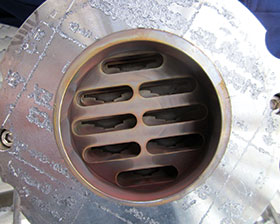

ELSTA, a joint venture between Delta, Essent and the American company, AES, is one of the most environmentally-friendly thermal power stations in the world. Compared to older power stations of the same design, ELSTA has an impressive 75% efficiency and consequently, makes a significant contribution to reducing CO2.
In addition to generating electricity for the Dutch power supply network and the neighbouring chemical complex operated by Dow Chemicals, the Terneuzen-based power station also generates heat in the form of steam for 17 neighbouring industrial companies.
The heart of the thermal power station consists of three gas turbines, exhaust gas boilers and one steam turbine. The gas turbines are able to supply a total of 123 MW of electricity and 450 tonnes of 90-bar-steam per hour.
The steam turbine produces an additional 90 MW of electricity and releases 35-bar-steam for the chemical complex in the form of process steam.
Flash steam control
A particular challenge in terms of control application is the so-called ‘flash steam control’ at the outlet of the economiser, a component located at the end of the steam boiler medium pressure system. For process-related reasons the flash steam controller, originally equipped with a poppet conical control valve, was subject to enormous wear.
The economiser preheats the boiler feed water using hot smoke gases and is fundamental to the increase of efficiency for the entire installation. The primary task of the flash steam controller in this process is to prevent the generation of steam in the economiser in the event of a low boiler load. If the boiler load is low, the feed water can heat up quickly and evaporate before reaching the actual steam vessel. As this is not desirable, the flash steam control valve opens so that some of the overheated feed water is guided back into the feed vessel. A large amount of feed water at an optimised low temperature is now available at the economiser outlet.
The flash steam control valve is temperature-controlled and the target value of the temperature depends upon the steam pressure on the valve inlet side. In this application, the task of the control valve is therefore to keep the feed water temperature beneath the saturation temperature of the steam at the relevant pressure level. In normal operating conditions, the control valve works with a linear characteristic curve for 12 hours per day with a valve opening of between 0 and 30%. As the valve controls mainly in the lower part of its operational range, a significant load is placed on the throttling element.
The original control valve had been equipped with an anti-cavitation poppet-conical seat produced from an extremely expensive stainless martensitic steel alloy. Despite this, the valve bottom section had to be replaced every two years due to severe damage caused by cavitation the pressure drop.
Tackling cavitation
The principle of the sliding gate valve makes it easier to tackle cavitation. At the heart of this design are two slotted discs that slide against each other and form a seal. The sealing disc, which is secured in the housing perpendicular to the direction of flow, is equipped with a calculated number of transverse slots. A further sealing disc with the same slotted arrangement is moved vertically against this, thus changing the flow. The differential pressure across the valve pushes both sealing discs against each other and ensures the sealing effect.
Although some operating conditions under which cavitation occurs cannot be avoided, the geometry of the sliding gate valve with its straight flow guidance and the short installation length, neutralises this problem as the implosion of the steam bubbles will only occur in the pipe downstream of the valve. If there are no adjacent pipe walls in this area (e.g. pipe bends), the cavitation will have no damaging effect. Therefore, it is usually sufficient to have only a small number of diameters of straight lengths of pipe down-stream of the valve.
Following a year of operation, the installed Schubert & Salzer sliding gate valve was disassembled during a planned shutdown in order to be examined. Except for the normal signs of usage, it was not possible to determine any additional wear on the sealing discs.
For more information contact Keith Hedges, Macsteel Fluid Control, +27 (0)82 575 9354, [email protected], www.macsteel.co.za

© Technews Publishing (Pty) Ltd | All Rights Reserved